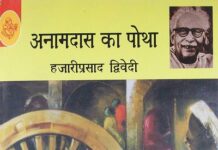 Another Bibliophile recommended this book Dar Dar Gange to me. And I immediately picked it up, as it was one of the very few contemporary works in Hindi that I came across. On top of that, it spoke about a journey across Ganga. Right from its source at Gangotri to its merging with the sea at Gangasagar. Earlier I had read another book by Julian Crandall Hollick covering the same journey. He and his wife also traveled across the length of Ganga covering more or less the same issues. They even traveled on the small boats and not on road most of the times. The times have changed a bit since they traveled. And the perspective of Indians, especially Hindus is bound to be different than foreigners who may understand but not internalize the cultural ethos of a river.
Another Bibliophile recommended this book Dar Dar Gange to me. And I immediately picked it up, as it was one of the very few contemporary works in Hindi that I came across. On top of that, it spoke about a journey across Ganga. Right from its source at Gangotri to its merging with the sea at Gangasagar. Earlier I had read another book by Julian Crandall Hollick covering the same journey. He and his wife also traveled across the length of Ganga covering more or less the same issues. They even traveled on the small boats and not on road most of the times. The times have changed a bit since they traveled. And the perspective of Indians, especially Hindus is bound to be different than foreigners who may understand but not internalize the cultural ethos of a river.
Authors have traveled across Ganga in three trips. Covering not just the famous stops on Ganga but some small stops as well, where there are small stories hidden some old and most new written in last few decades. Ganga is dying is something that we hear every day. Every other day governments announce plans to clean Ganga, to save Ganga. But we all know what that has meant for either the river or the economy that used to thrive on its banks. Modern myths put most of the blame for the destruction of Ganga’s ecosystem on Tehri Dam and Kanpur primarily. While across her length people are exploiting her, playing with her natural flow by dividing it or trying to hold it, by building barrages across it. But at the same time continuing to call it a mother who hopefully will forgive every sin done towards her.
At every few kilometers, authors have interacted with people on the banks of Ganga. And woven a fictitious story to tell the woes of those whose livelihood was dependent on Ganga like Pandits and boatmen. They have tried to uncover the nexus between government and businesses that are playing havoc. And they have tried to look at the devotion or Astha that people still have in Ganga. Each story follows a similar pattern but tells a new woe, some generic and some specific to the place. Somewhere it is the need of electricity, a somewhere radioactive material is being dumped into it, somewhere the survival of the leather industry, somewhere the need of fishing and killing the dolphins. And at most places the sewage from the cities flowing directly into it.
Some hope shines through the environmentalists who are trying their bit to keep the river and life around it intact. The apathy of the government machinery in solving the issues and their giving away to businesses that only want instant gain is worrying, to say the least. Overall the mood is that of melancholy.
I always knew that Ganga is very important in Varanasi because it is Uttarvahini there, i.e. it flows northwards. And mythically it is said that it looks back towards its source before merging with the ocean. Authors in this book mention quite a few places where Ganga flows northwards. And at all the places there is a story and an important worship spot. I wish they had explained what is the significance of Uttarvahini. And why it gains importance at these points.
Language is very good, flows almost like the flow of Ganga. In a short story format, it stops every few pages for the next turn. Stories have been fictionalized, but do names really matter for such grave matters.
Read Dar Dar Gange for a good work in Hindi and to know the real status of Ganga and its banks at this point in time.









The reason why I recommended this book seems to be well imbibed in review – well read and explained ! I tell (and request) everyone to read this for the sake of awareness and to know the extent at which Ganga has been abused.
Thank you for recommending Aamit. Can not say enjoyed, but like you say lot of awareness came. Wish we could do such journeys across all rivers in the country.